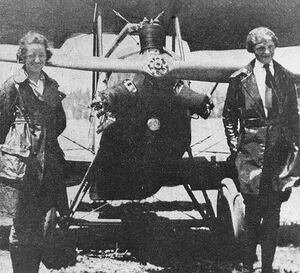Engineering:Kinner Airster
| Airster | |
|---|---|

| |
| L–R: Neta Snook and Amelia Earhart in front of Earhart's Airster, c.1921 | |
| Role | Two-seat biplane |
| National origin | United States |
| Manufacturer | Kinner Airplane & Motor Corporation |
| Designer | Bert Kinner |
| First flight | 1920 |
The Kinner Airster is an American two-seat single-engined biplane designed by Bert Kinner and built by his Kinner Airplane & Motor Corporation.[1]
Development
The Airster appeared in 1920 designed by Bert Kinner, it was a one or two seat open-cockpit single-engine biplane. The first single-seat Airster was powered by a 60 hp (45 kW) Lawrance L-4 radial engine. When the prototype crashed on a test flight it was rebuilt as a two-seater with a wider cockpit. One Airster named The Canary was bought by Amelia Earhart while she was learning to fly. Later production aircraft had slab-sided plywood fuselages and were powered by a variety of 60 hp (45 kW) engines.[1]
In 1927 the company produced a three-seat variant powered by a 100 hp (75 kW) Kinner K-2 engine, with the last Airster being built in 1927. Design rights were sold to the Crown Carriage Works in 1929 who produced a version designated the Crown B-3.[1]
Specifications
Data from [1]
General characteristics
- Crew: 2
- Length: 21 ft 4 in (6.50 m)
- Wingspan: 28 ft 0 in (8.53 m)
- Powerplant: 1 × Lawrance L-5 radial piston engine, 60 hp (45 kW)
Performance
- Maximum speed: 85 mph (137 km/h, 74 kn)
- Cruise speed: 70 mph (110 km/h, 61 kn)
- Range: 300 mi (480 km, 260 nmi)
- Service ceiling: 14,000 ft (4,300 m)
References
- ↑ Jump up to: 1.0 1.1 1.2 1.3 "American airplanes - Kinner". www.aerofiles.com. 7 April 2009. http://aerofiles.com/_kinner.html. Retrieved 2010-01-01.
 |


